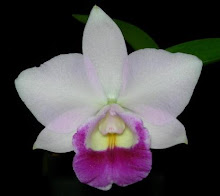Ken Slump's article in the July 2009 'Orchids' magazine finished just as it got interesting.
Like Ken I don't harbor any delusions that my collection is important, however I'm starting to virus test my collection for a few reasons.
1) I share my orchids. I give away back divisions, put plants on the plant table or in my society's annual BBQ and auction. I'd like to be sure I don't give away a bum plant. *Granted* the tests are only for CymMV and ORSV but at least I'm making that effort.
2) I don't need to tarnish my reputation by giving away back divisions of virused plants. That's all I need, to have someone get all happy that they got a plant from me, then have that happiness turn to ash. Nope. Not worth it. Not a way to win friends and influence people.
3) To cull the collection. Let's face it. Bench space is at a premium. Why invest time trouble and bench space on a virused plant? It can infect the rest of your collection. Nothing's worse than waiting all year for an orchid to bloom then pfft! Color break. Is it virus? Is it poor culture? Is it a result of a pesticide? Now I can test and make an informed decision about whether to toss the plant or not.
Yes, the strips cost a freaking arm and a leg.
Yes, they only test for 2 of the myriad of viruses that infect orchids.
Yes, I'm kidding myself, but I can sleep at night.
Ken's article goes on to list the whole range of virus rumors, among them: Paphs don't get viruses; ants, thrips, & scale can bring in viruses; water dripping from one virused plant onto another can pass virus along.
That last one is what keeps me up at night, LOL! I've seen plenty of hobby greenhouses, mine included, with plants hanging on top of others. There's no way not to splash water from one plant to the next. Again, IMHO get the virused plants out of the collection before they can cause trouble. [Speaking of which, Carl Jukkola did a study of his cymbidiums and virus spread within his collection... he found the leaves whipping in the breeze can cause cuts and transmit viruses.....well I really shouldn't quote him since I never read his study. Maybe Carl will get it printed in a magazine one of these days.]
True, when you start thinking about this stuff it can drive you crazy. But I go back to my 3 reasons for testing, and it makes sense to me.



